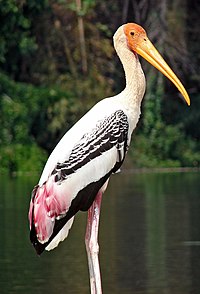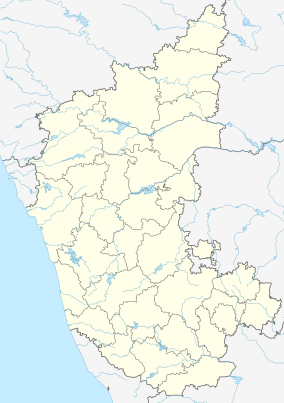Ranganathittu Bird Sanctuary
| Ranganathittu Bird Sanctuary | |
|---|---|
|
IUCN category IV (habitat/species management area)
|
|

A painted stork in the sanctuary
|
|
|
Location in Map of Karnataka
|
|
| Location | Mandya, Karnataka, India |
| Coordinates | 12°24′N 76°39′E / 12.400°N 76.650°ECoordinates: 12°24′N 76°39′E / 12.400°N 76.650°E |
| Area | 40 acres (16 ha) |
| Established | 1940 |
| Visitors | 304,000 (in 2016–17) |
| Governing body | Ministry of Environment and Forests, Government of India |
Ranganathittu Bird Sanctuary (Kannada: ರಂಗನತಿಟ್ಟು ಪಕ್ಷಿಧಾಮ) also known as Pakshi Kashi of Karnataka is a bird sanctuary in the Mandya District of the state of Karnataka in India. It is the largest bird sanctuary in the state, only 40 acres (16 ha) in area, and comprises six islets on the banks of the Kaveri river. Ranganathittu is located three kilometers away from the historic town of Srirangapatna and 16 kilometres (9.9 mi) north of Mysore. The sanctuary attracted about 3 lakh visitors during 2016–17, which shows its notability as important bird sanctuary of India.
The islets came into being when an embarkment across the Kaveri river was built in 1648 by the then Mysore King, Kanteerava Narasimharaja Wadiyar. The ornithologist Salim Ali observed that the isles formed an important nesting ground for birds, and persuaded the Wodeyar kings of Mysore to declare the area a wildlife sanctuary in 1940. The Forest Department of Karnataka State is maintaining the bird sanctuary and puts its efforts to improve the sanctuary, which include purchase of nearby private lands to expand the protected area.
The sanctuary with its islets experience heavy flooding during certain rainy seasons when water is released from KRS Dam upstream, due to heavy rains. During heavy flooding boating is suspended and tourists are allowed to watch the nesting birds from a distance. Frequent flooding has also damaged some portions of three islands over past few decades.
Most of the park falls under the Riparian biome, corresponding to the Indomalaya ecozone.
Riverine reed beds cover the banks of the islands, while the islands themselves are covered in broadleaf forests, with dominant species being Terminalia arjuna (arjun tree), bamboo groves, and Pandanus trees. Eucalyptus and acacia trees have also been planted, which might lead to long-term eradication of native species. The endemic and threatened lily Iphigenia mysorensis of the family Colchicaceae also grows in the sanctuary.
...
Wikipedia

